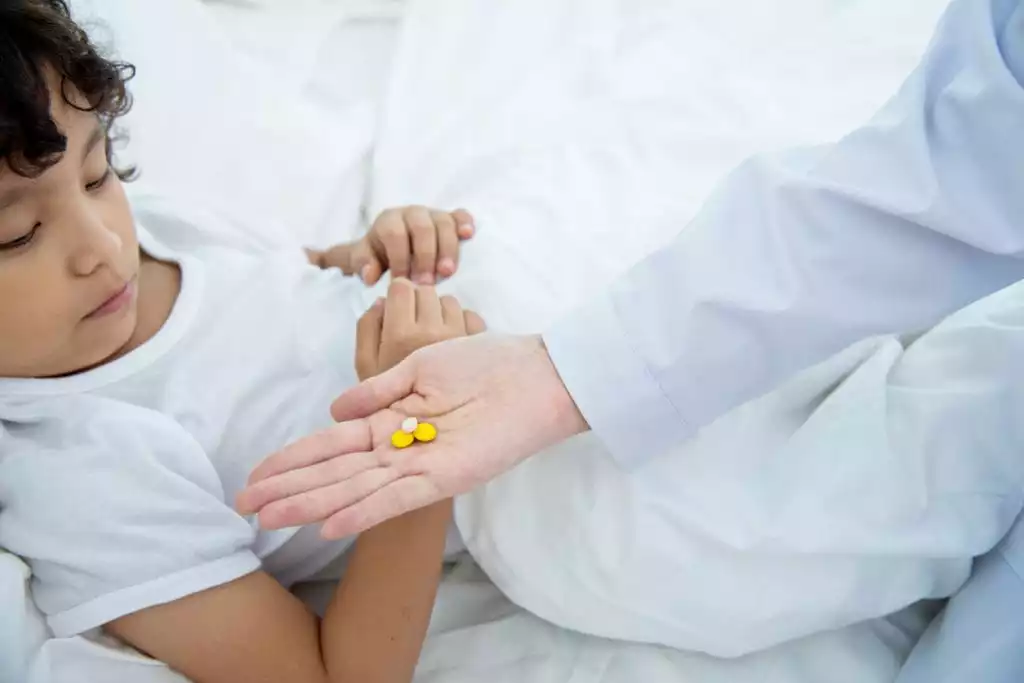
It’s 3 a.m. You wake up to the sound of your child crying – and coughing. Oh dear; it’s a dreaded winter cold. You have options: give your child medicine or try to ride it out. You opt for the medicine, but when you head to the medicine cabinet, you aren’t sure which is the best children’s medicine to give.
She’s feverish and coughing, but she isn’t congested. She’s nauseous, but she isn’t throwing up. You stare blankly at a shelf full of Children’s Benadryl, Acetaminophen, Triaminic Cough & Cold, Dramamine, Motrin, and a few adult medications.
Eventually, you end up closing the door and placing an after-hours call to your pediatrician, who advises you (after asking a few questions) to try the Triaminic. He also suggests turning on a humidifier beside her bed. You do both, and the cough quiets down.
Ah, rest.
Too Many Options?
This scenario isn’t unusual; in fact, it plays out in American households every night of the year. Parents often struggle to identify the best medication for every situation, and unfortunately, it just isn’t always possible to place a call to the doctor. It doesn’t always happen at night, either; sometimes it’s as simple as feeling confused at the pharmacy.
While asking your pharmacist or doctor is always best, there are ways to make the process of choosing children’s medicine easier. Start with this easy step-by-step guide.
Finding the Best Children’s Medicine Based on Symptoms
If your child is already sick, begin by quickly assessing his or her symptoms. If old enough, ask your little one how they feel. Check for issues like:
- Coughing
- Sneezing
- Fever
- Nausea
- Headache
- Vomiting
- Abdominal pain
- Muscle pain
- Wheezing
- Diarrhea
- Any other symptoms
Ideally, you will match this list of symptoms to the children’s medicine that is best-suited to your child’s needs. However, you never want to give a medication for any need if it will be unsafe to do so.
We also want to make a small note of caution: before giving any children’s medicine, judge the severity of your child’s symptoms. If a symptom is particularly severe, it’s better to call the doctor or pharmacist than not. Specifically, fevers over 103 F (39.4 C) merit an immediate call to the doctor, unless your child is under three months old. In that case, call the doctor at the first sign of any fever. Other problematic symptoms include breathing difficulties, bluish lips or fingers, tremors, convulsions, and clear signs of intense pain.
Consider Contraindications
Some medications contraindicate others, meaning the two children’s medicine options cannot be taken together because the combination causes harm. This “harm” may be mild, like itching, or very serious, like liver failure or stroke.
To make the situation even more complicated, not every contraindication will produce negative symptoms for every patient. Sometimes, patients will tolerate the doses fine a few times and then suddenly experience side effects. That’s why you should take care to rule out contraindications every time, no matter how innocuous they may seem.
The most common contraindication is by far accidentally giving the same children’s medicine twice. This commonly occurs when parents give two combination medications that contain the same drug – for example, cold medicines.
The best way to avoid this is to read and compare labels for all drugs the child is taking beforehand. Remember that dose and daily maximums are for the total amount of a substance, not per medication!
Contraindications like these don’t always mean your child can’t use a medication at all; in many cases, pharmacy pediatric compounding can make a med safe to use again. This includes dosage format changes or the removal of a problem substance to create a new formula.
Your compounding pharmacist can also change the delivery method of your children’s medicine to make it easier for your child to take. They can also add or remove ingredients based on necessity or personal preference as well.
Ask your pharmacist if you have questions!
Consider Pre-Existing Health Concerns
Sometimes contraindications happen because of medical conditions, rather than combining medications. A parent may inadvertently give an allergen or may give a medication that produces serious negative harm due to a medical condition (e.g., giving a child with ulcers NSAIDs).
If your child has a serious medical condition, like liver, heart, kidney, or gastrointestinal disease, speak with your pharmacist before choosing a medication. Some children’s medicine, like Children’s Motrin, can exacerbate their symptoms or even cause serious harm. Others require a dosage adjustment for safe use.
Also note that simply being too young for OTC medication is a concern. Children under the age of one year are often more sensitive to medications, and thus, their age may contraindicate medication use. It’s safer to have your doctor prescribe a specific dose than to try to guess on your own.
Lastly, if your child takes any daily medications (be they for physical or mental health issues) you should not give over-the-counter medications period without consulting a pharmacist. While many drugs can safely be combined or used together, determining which cannot is too complicated for the average layperson. This isn’t meant as an insult – most pharmacists have access to contraindication bibles to help guide their decisions.
Plan for the Future
If your child isn’t sick, you can still plan for the future by stocking your medicine cabinet with medicines that will help. Use the same symptom list and stock up on standard solutions recommended by your pharmacist. Be sure to tell your pharmacist if your child is taking any regular medications or if he or she has any specific medical conditions as these can impact which medications your child can take.
It’s a good idea to have at least three days of children’s medicine for mild illnesses available in your medicine cabinet at all times. The most common three are Benadryl, Tylenol, and Motrin (diphenhydramine, acetaminophen, and ibuprofen respectively).
Don’t forget that just because you have medicine on-hand, doesn’t mean you should necessarily use it every time for every symptom. Children with the flu who are vomiting, for example, should generally be allowed to vomit provided that they can keep down fluids and stay hydrated. This is also true for children with diarrhea and little ones who are coughing productively. Coughing, vomiting, and diarrhea are the body’s way of ridding itself of germs, so they do serve a purpose. Medications are best given when the goal is to simply get a bit of rest or bring symptoms down to a tolerable level.
The best advice we can give you about choosing children’s medicine is also the simplest: talk to your pharmacist. Medication and treatment can be an incredibly complicated, patient-specific task, but you and your pharmacist ultimately have the same goal: to help your child be well again. He or she can review your child’s history and conditions to find the safest, most effective option.

 info@burtsrx.com
info@burtsrx.com

